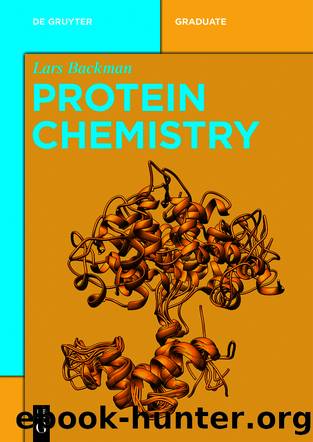Protein Chemistry by Lars Backman

Author:Lars Backman
Language: eng
Format: epub
Publisher: De Gruyter
Published: 2019-12-02T13:57:46.475000+00:00
8.5
Integral membrane proteins
It is much more challenging to determine the structure of an integral membrane protein than of a soluble protein. It must be possible to release the membrane protein from the membrane in an undamaged and stable form. As a membrane protein is partly hydrophobic and partly hydrophilic, it is difficult to keep the protein in solution. These are the first obstacles on the way to a structure. Still, there are two major reasons that motivate the study of these stubborn proteins: they constitute around 30% of the human proteome and around 50% of current drug targets.
It was not until the 1980s proper conditions had been worked out to obtain crystals of membrane proteins. Soon after, the first high-resolution structure of an integral membrane protein was published. Johann Deisenhofer, Robert Huber and Hartmut Michel were able to isolate, crystallize and determine the structure of the photosynthetic reaction center of the purple bacteria Rhodopseudomonas viridis by X-ray crystallography.
However, 10 years before a low-resolution model of bacteriorhodopsin, a light-driven hydrogen pump from the purple bacteria Halobacterium halobium was presented by Richard Henderson and Nigel Unwin. The structure, determined by electron microscopy, did not display any fine details, such as position of sidechains (Figure 8.6).
Download
This site does not store any files on its server. We only index and link to content provided by other sites. Please contact the content providers to delete copyright contents if any and email us, we'll remove relevant links or contents immediately.
Alchemy and Alchemists by C. J. S. Thompson(3447)
The Elements by Theodore Gray(2994)
The Club by A.L. Brooks(2862)
How to Make Your Own Soap by Sally Hornsey(2826)
Drugs Unlimited by Mike Power(2543)
Wheels of Life by Anodea Judith(2093)
Cracking the LSAT, 2012 Edition by Princeton Review(1867)
Cracking the Sat French Subject Test, 2013-2014 Edition by The Princeton Review(1827)
Perfume by Jean-Claude Ellena(1781)
The Flavor Matrix by James Briscione(1773)
The Cosmic Machine: The Science That Runs Our Universe and the Story Behind It by Scott Bembenek(1725)
MCAT Physics and Math Review by Princeton Review(1634)
1000 Multiple-Choice Questions in Organic Chemistry by Organic Chemistry Academy(1621)
The Thing Around Your Neck by Chimamanda Ngozi Adichie(1597)
Handbook of Modern Sensors by Jacob Fraden(1541)
Cracking the SAT Premium Edition with 6 Practice Tests, 2017 by Princeton Review(1535)
Synchrotron Light Sources and Free-Electron Lasers by Eberhard J. Jaeschke Shaukat Khan Jochen R. Schneider & Jerome B. Hastings(1522)
A is for Arsenic: The Poisons of Agatha Christie (Bloomsbury Sigma) by Kathryn Harkup(1504)
Harry Potter All Books: 8 Books by J.k.rowling(1489)
